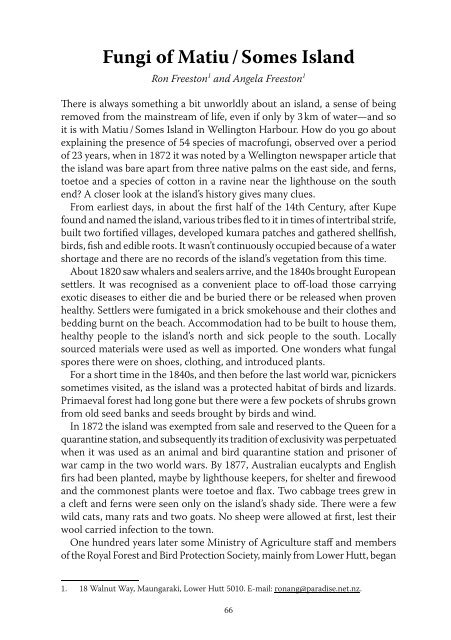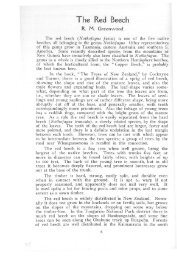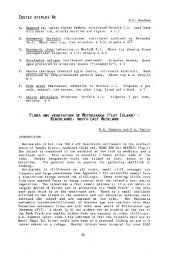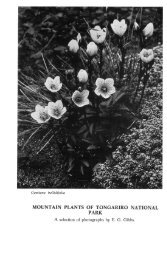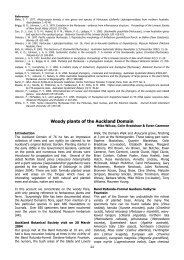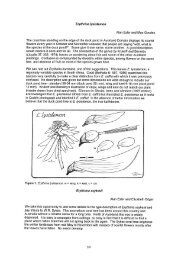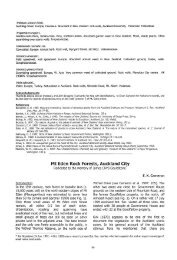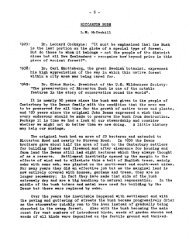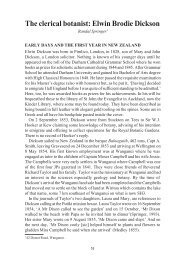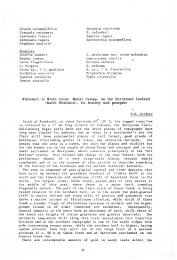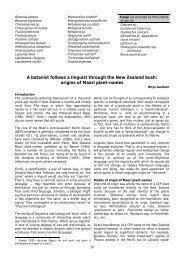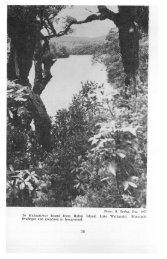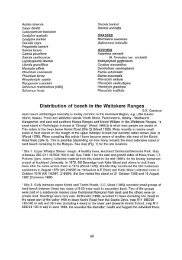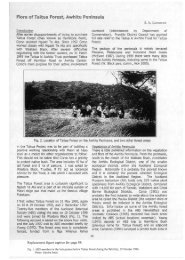fungi of matiu / Somes Island - New Zealand Regional Botanical ...
fungi of matiu / Somes Island - New Zealand Regional Botanical ...
fungi of matiu / Somes Island - New Zealand Regional Botanical ...
Create successful ePaper yourself
Turn your PDF publications into a flip-book with our unique Google optimized e-Paper software.
<strong>fungi</strong> <strong>of</strong> <strong>matiu</strong> / <strong>Somes</strong> <strong>Island</strong><br />
Ron Freeston 1 and Angela Freeston 1<br />
There is always something a bit unworldly about an island, a sense <strong>of</strong> being<br />
removed from the mainstream <strong>of</strong> life, even if only by 3 km <strong>of</strong> water—and so<br />
it is with Matiu / <strong>Somes</strong> <strong>Island</strong> in Wellington Harbour. How do you go about<br />
explaining the presence <strong>of</strong> 54 species <strong>of</strong> macro<strong>fungi</strong>, observed over a period<br />
<strong>of</strong> 23 years, when in 1872 it was noted by a Wellington newspaper article that<br />
the island was bare apart from three native palms on the east side, and ferns,<br />
toetoe and a species <strong>of</strong> cotton in a ravine near the lighthouse on the south<br />
end A closer look at the island’s history gives many clues.<br />
From earliest days, in about the first half <strong>of</strong> the 14th Century, after Kupe<br />
found and named the island, various tribes fled to it in times <strong>of</strong> intertribal strife,<br />
built two fortified villages, developed kumara patches and gathered shellfish,<br />
birds, fish and edible roots. It wasn’t continuously occupied because <strong>of</strong> a water<br />
shortage and there are no records <strong>of</strong> the island’s vegetation from this time.<br />
About 1820 saw whalers and sealers arrive, and the 1840s brought European<br />
settlers. It was recognised as a convenient place to <strong>of</strong>f-load those carrying<br />
exotic diseases to either die and be buried there or be released when proven<br />
healthy. Settlers were fumigated in a brick smokehouse and their clothes and<br />
bedding burnt on the beach. Accommodation had to be built to house them,<br />
healthy people to the island’s north and sick people to the south. Locally<br />
sourced materials were used as well as imported. One wonders what fungal<br />
spores there were on shoes, clothing, and introduced plants.<br />
For a short time in the 1840s, and then before the last world war, picnickers<br />
sometimes visited, as the island was a protected habitat <strong>of</strong> birds and lizards.<br />
Primaeval forest had long gone but there were a few pockets <strong>of</strong> shrubs grown<br />
from old seed banks and seeds brought by birds and wind.<br />
In 1872 the island was exempted from sale and reserved to the Queen for a<br />
quarantine station, and subsequently its tradition <strong>of</strong> exclusivity was perpetuated<br />
when it was used as an animal and bird quarantine station and prisoner <strong>of</strong><br />
war camp in the two world wars. By 1877, Australian eucalypts and English<br />
firs had been planted, maybe by lighthouse keepers, for shelter and firewood<br />
and the commonest plants were toetoe and flax. Two cabbage trees grew in<br />
a cleft and ferns were seen only on the island’s shady side. There were a few<br />
wild cats, many rats and two goats. No sheep were allowed at first, lest their<br />
wool carried infection to the town.<br />
One hundred years later some Ministry <strong>of</strong> Agriculture staff and members<br />
<strong>of</strong> the Royal Forest and Bird Protection Society, mainly from Lower Hutt, began<br />
1. 18 Walnut Way, Maungaraki, Lower Hutt 5010. E-mail: ronang@paradise.net.nz.<br />
66
Freeston & Freeston—Matiu / <strong>Somes</strong> <strong>Island</strong> <strong>fungi</strong><br />
to augment the patches <strong>of</strong> vegetation which straggled mainly around the fringes<br />
<strong>of</strong> the island. The largest was quite a pocket <strong>of</strong> karaka, ngaio, karo, pōhutukawa<br />
and prominent pines above the wharf. Flaxes survived well even in the windiest<br />
spots. Olearia, taupata, Muehlenbeckia, a few pūriri, native fuchsia and even<br />
a whau began to be joined by thousands <strong>of</strong> trees native to the surrounding<br />
hillsides. The last hillside has now been planted and non-native species are<br />
being removed.<br />
It is interesting to wonder what types <strong>of</strong> <strong>fungi</strong> lurk in the soils. In the rich<br />
soils <strong>of</strong> the areas where the lighthouse keepers and quarantine workers kept<br />
flocks <strong>of</strong> sheep, the edible Agaricus campestris, species <strong>of</strong> Chlorophyllum and<br />
Lycoperdon are found. The various species <strong>of</strong> Pinus growing on the island<br />
proved treasure troves because <strong>of</strong> their age. In grass amongst their roots are<br />
red and white Amanita muscaria and big, fleshy, brown-capped Lepista nuda<br />
with bright purple gills and white, purple-flushed stipes. On one ancient stormwracked<br />
Cupressus macrocarpa were two prized specimens <strong>of</strong> Tyromyces<br />
setiger with its bristly upper surface<br />
and distinctive blue-white tints.<br />
Other conifers held shelf fungus<br />
Phellinus wahlbergii, bright orange<br />
Pycnoporus coccineus (formerly<br />
mis-identified in <strong>New</strong> <strong>Zealand</strong> as<br />
P. cinnabarinus), the ruffled fanshaped<br />
and striped brown, orange,<br />
grey and green Trametes versicolor<br />
and the hairy Trametes hirsuta.<br />
Fallen and decaying branches<br />
Tyromyces setiger.<br />
Photos: Ron & Angela Freeston.<br />
and twigs <strong>of</strong> karaka, pōhutukawa, ngaio, karo, pūriri and Leptospermum<br />
scoparium are difficult to identify but held many <strong>fungi</strong>. There are delicate<br />
cream-coloured, kidney shaped Crepidotus mollis and C. variabilis; thick,<br />
brown, ear-like Auricularia cornea and droves <strong>of</strong> radially grooved bell-like<br />
Coprinus disseminatus that change colour from cream to grey and have a<br />
striking yellow apex.<br />
Chlorophyllum rachodes (left) and Favolaschia calocera.<br />
67
Wellington <strong>Botanical</strong> Society Bulletin 51, November 2008<br />
As logs fall and age they <strong>of</strong>ten have a succession <strong>of</strong> colonisers; a group <strong>of</strong><br />
orange-brown pointy capped Galerina sp. one year, the next invariably a velvety<br />
net-patterned Pluteus velutinornatus, and later the black, white spore-tipped<br />
dead men’s fingers <strong>of</strong> Xylaria hypoxylon. Before complete disintegration <strong>of</strong><br />
Leptospermum branches, the fresh pink splotches with white woolly margins<br />
<strong>of</strong> Aleurodiscus ochrace<strong>of</strong>lavus are seen. Cut ends <strong>of</strong> logs are preferred habitat<br />
<strong>of</strong> the tiny jelly-like fingers <strong>of</strong> Dacrymyces stillatus, and on the old roots are<br />
<strong>of</strong>ten large, bright orange specimens <strong>of</strong> Gymnopilus junonius with caps up to<br />
15 cm diameter and wide rings on their stems. Wound sites on old ngaio trees<br />
hold Marasmius sp. and about 10 years ago fallen branches began to be coated<br />
with drifts <strong>of</strong> Favolaschia calocera, a charming orange fungus with little holes<br />
on the underside. This fungus, from Madagascar, first appeared in <strong>New</strong> <strong>Zealand</strong><br />
about 1970 and is a widespread invasive species likely to compete with native<br />
species. It is always a pleasure to find twigs with ‘birds nest’ <strong>fungi</strong> (Cyathus<br />
olla) with its little round cups filled with egg shaped spore packets, ready to<br />
be splashed out by a drop <strong>of</strong> rain.<br />
The distinctive brown circular caps <strong>of</strong> Polyporus arcularius made their trip<br />
to the island on a sheet <strong>of</strong> plywood used in the nursery where indigenous<br />
native plants are propagated.<br />
The bright red Stropharia<br />
aurantiaca grow happily in the<br />
sawdust between the rows there.<br />
In the soil and potting mix in the<br />
plant pots Inocybe sp. flourish<br />
and over the past three years are<br />
making their way down zigzag<br />
paths beneath the nursery. Leaf<br />
litter is always a rich source<br />
<strong>of</strong> <strong>fungi</strong> and Matiu/<strong>Somes</strong><br />
<strong>Island</strong> had Paurocotylis pila, a<br />
species similar in appearance<br />
to Lyophyllum decastes, the<br />
ubiquitous Laccaria laccata and<br />
the lacy basket-like Ileodictyon<br />
cibarium with its odorous spore<br />
filled gleba. By far the most<br />
exciting find was a species <strong>of</strong><br />
Amanita with a pointed cap and<br />
stipe thickly covered with felty<br />
grey scales.<br />
A very distinctive Amanita species<br />
known only from <strong>New</strong> <strong>Zealand</strong>.<br />
68


